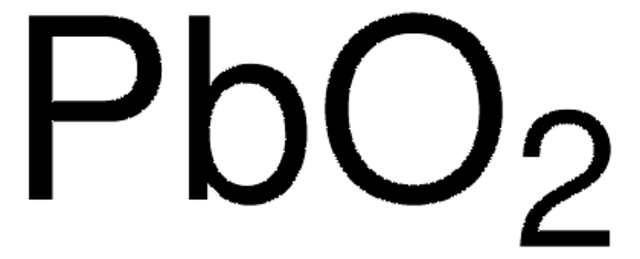Wichtige Dokumente
254258
Blei(II)-sulfat
99.995% trace metals basis
Synonym(e):
Anglesite
About This Item
Empfohlene Produkte
Qualität
for analytical purposes
Qualitätsniveau
Assay
99.995% trace metals basis
Form
powder and chunks
Eignung der Reaktion
reagent type: catalyst
core: lead
Verunreinigungen
≤55.0 ppm Trace Metal Analysis
Dichte
6.2 g/mL at 25 °C (lit.)
SMILES String
[PbH2++].[O-]S([O-])(=O)=O
InChI
1S/H2O4S.Pb/c1-5(2,3)4;/h(H2,1,2,3,4);/q;+2/p-2
InChIKey
KEQXNNJHMWSZHK-UHFFFAOYSA-L
Suchen Sie nach ähnlichen Produkten? Aufrufen Leitfaden zum Produktvergleich
Anwendung
- Lead(II) sulfate uses.: Widely recognized for its role in lead-acid battery technology, Lead(II) sulfate is pivotal in the production of battery plates. It contributes to the battery′s ability to store and release energy efficiently, which is critical in automotive and renewable energy storage applications (DOI: 10.1039/d3ra04386j).
Signalwort
Danger
H-Sätze
Gefahreneinstufungen
Acute Tox. 4 Inhalation - Acute Tox. 4 Oral - Aquatic Acute 1 - Aquatic Chronic 1 - Repr. 1A - STOT RE 2
Lagerklassenschlüssel
6.1C - Combustible acute toxic Cat.3 / toxic compounds or compounds which causing chronic effects
WGK
WGK 3
Flammpunkt (°F)
Not applicable
Flammpunkt (°C)
Not applicable
Persönliche Schutzausrüstung
dust mask type N95 (US), Eyeshields, Gloves, type P2 (EN 143) respirator cartridges
Zulassungslistungen
Zulassungslistungen werden hauptsächlich für chemische Produkte erstellt. Für nicht-chemische Produkte können hier nur begrenzte Angaben gemacht werden. Kein Eintrag bedeutet, dass keine der Komponenten gelistet ist. Es liegt in der Verantwortung des Benutzers, die sichere und legale Verwendung des Produkts zu gewährleisten.
EU REACH Annex XVII (Restriction List)
Hier finden Sie alle aktuellen Versionen:
Besitzen Sie dieses Produkt bereits?
In der Dokumentenbibliothek finden Sie die Dokumentation zu den Produkten, die Sie kürzlich erworben haben.
Kunden haben sich ebenfalls angesehen
Artikel
Since the first report of the low-cost dye-sensitized solar cell (DSSC) in 1991 by Gratzel and his coworker,1 dye-sensitized solar cells (DSSC) has been regarded as one of the most promising photovoltaic technologies because of their transparent and colorful characteristics, as well as low cost.
Global Trade Item Number
| SKU | GTIN |
|---|---|
| 254258-250G | |
| 254258-10G | 4061825992822 |
| 254258-50G | 4061838138637 |
Unser Team von Wissenschaftlern verfügt über Erfahrung in allen Forschungsbereichen einschließlich Life Science, Materialwissenschaften, chemischer Synthese, Chromatographie, Analytik und vielen mehr..
Setzen Sie sich mit dem technischen Dienst in Verbindung.















